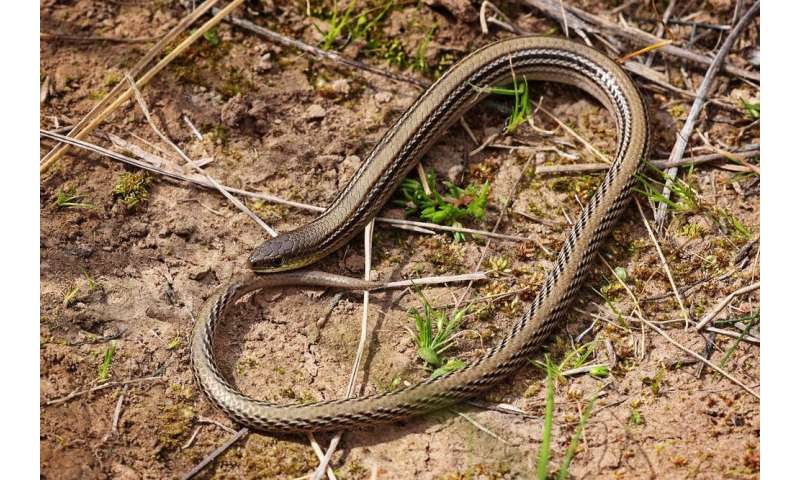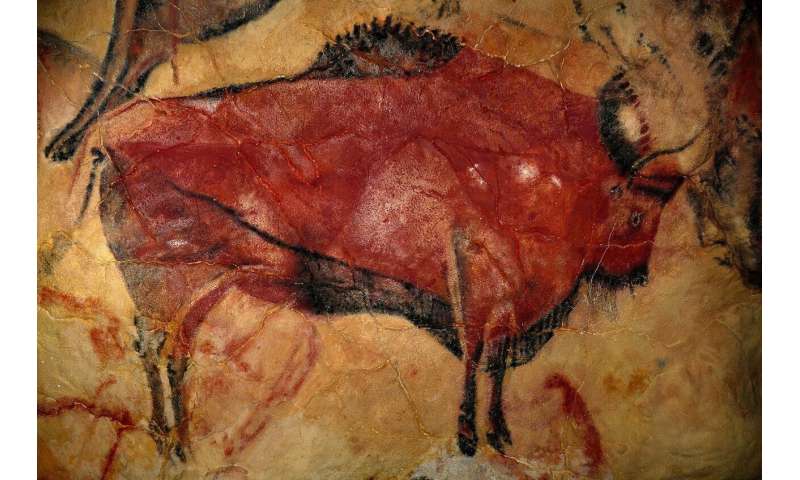In the north eastern Free State, a 60 km green corridor is being created that will link the upper Wilge Protected Environment to the Sneeuwberg.
The plan is to create a place of refuge for the bird species that are threatened by climate change and the destruction of South Africa's grasslands.
It will be an add-on to the already 17 456 hectares that became part of the Sneeuwberg Protected Environment in 2016.
For Dr. Melissa Howes-Whitecross, who works for BirdLife South Africa and is a Visiting Researcher at Wits' School of Animal, Plant and Environmental Sciences (APES), it is one answer to South Africa's dwindling unique grassland habitats.
As grasslands dwindle, so too does the biodiversity they sustain. Grassland mammals like Oribi and grey rhebok have experienced population declines, while grassland bird species have been particularly hard hit.
The bird that graces South Africa's coat of arms, the Secretary bird, has lost 50% of its population over the last three generations. To blame is habitat destruction, hunting and poisonings.
Other bird species are also being affected by climate change.
"Many of our grasslands are high altitude grasslands. We are finding that birds like the Yellow-breasted Pipit are extremely sensitive in terms of their breeding when it comes to average temperature increasing. So, there is a definite threshold where breeding fails," says Howes-Whitecross. "We are very concerned for these high-altitude grassland species."
The work towards creating green corridors is one of the first steps in protecting some of South Africa's most unique biodiversity, its grassland biome.
"One of the big problems about grasslands is that they are centered around places like Joburg, Bloemfontein and Pretoria, which means it is some of the most expensive land in the country," explains Professor Ed Witkowski, Head of the Restoration and Conservation Biology Research Group, and Professor of Plant Ecology at APES.
"There is a lot of mining activity in the area, it is valuable for agriculture and they have planted a lot of forests. So, declaring large areas of grasslands as nature reserves is expensive."
If the grasslands are wiped out, the loss will eventually impact the humans who were responsible for the destruction in the first place.
"It is a necessity for human well-being to have intact ecosystems. If you take a wetland, which usually falls within a grassland area, for example, they are vital for storing water, cleaning water and preventing floods," says Howes-Whitecross.
The Sneeuwberg Protected Environment happens to lie within a strategic water source area, which feeds rivers that provide water for many of South African cities. In a water-scarce country like South Africa, access to clean water is becoming a crisis, particularly for poorer communities.
As a recent study has shown, however, it is important that the right research is used in the fight against climate change and habitat destruction.
A paper by European scientists that appeared in Science, claimed that global tree planting could rid the planet of a third of the CO2 emitted since the industrial revolution. Africa's grasslands were suggested as a prime spot to plant large numbers of trees.
In a technical comment that was published as a response to this article and, also published in Science, 46 scientists—including Wits ecologist Professor Sally Archibald – warned that such large-scale afforestation could destroy ecological systems and do little to reduce CO2 levels.
"Firstly, their numbers are wrong," says Archibald. "It is irresponsible to give people false hope that our global change problems can be fixed in this way. Secondly, the impacts on our natural ecosystems in Africa would be devastating."
Famous veld flower
Near the town of Haenertsburg in Limpopo, Sylvie Kremer-Köhne, an MSc graduate from APES is trying to make a small rare plant species famous.
Aloe lettyae has been made a flagship species for grasslands, meaning it has—much like a rhino—been chosen to be an ambassador for a particular habitat.
The aloe was described in 1937 and, until recently, little was known about its biology.
"It is our flagship species because it only occurs in the critically endangered Woodbush Granite Grassland, of which very little is left," says Kremer-Köhne. "So the first job was to figure out just how many populations there are, and where exactly they are."
The count revealed 10,800 plants clustered in several population groups.
Over the last century, exotic timber plantations—exactly what Archibald warns against—are believed to have destroyed more than 90% of the original Woodbush Granite Grassland. What is left is now squeezed onto small fragmented pieces of land.
In 1917 botanist Illtyd Buller Pole-Evans took a photograph of the Magoebaskloof, which lies close to Haenertsburg. A century later, a photographer stood in the near same spot as Pole-Evans and took an image of the same mountain.
What it revealed was how the Woodland Granite Grassland had been wiped out over the course of a century. Back in 1917, when the photograph was taken, the mountain was blanketed in grassland. By 2017, Magoebaskloof was covered by heavily wooded vegetation.
To Witkowski, the two photographs show the devastating effect humans have had on the environment. "You see a combination of plantations and bush encroachment," he says, adding that the bush encroachment on the mountain was most likely fuelled by global climate change and altered fire regimes to protect the plantation trees.
The biggest remnant of this grassland type is now protected in a 126-hectare provincial reserve that has been established just outside Haenertsburg. However, Kremer-Köhne believes it is not enough. Other measures need to be taken to protect this crucial ecosystem, such as ongoing efforts to teach farmers to farm in a way that minimises their impact on natural grasslands.
But, ultimately, it comes down to changing the way humans think about themselves. "As humans we often forget that we are just another cog in a big natural wheel that is turning," says Howes-Whitecross.
How grass dances with fire

There's a long-held myth that Johannesburg is the globe's largest urban forest, resplendent with an annual purple Jacaranda show. But before the planting of these (alien) trees for timber during the Gold Rush in the 19th Century, Johannesburg was a rich and varied grassland—a biome [community of plants and animals] that is one of the least protected in South Africa. Fortunately, the Department of Environmental Affairs prohibits plantation forestry in our grasslands, because of the negative impact it has on water resources and biodiversity.
Sally Archibald, Associate Professor in the School of Animal, Plant and Environmental Sciences (APES) at Wits, explains that grass-dominated environments comprise 40% of Earth's land area and they are critical for the livelihoods of much of the developing world. The Food and Agriculture Organization of the United Nations has made the preservation of such grasslands a priority.
First fires at Frankenwald
Grasslands are Darwinian gold medalists—they have adapted to almost all environmental stressors, including grazing animals and freezing temperatures. Some people might find it hard to understand, but protecting delicate grassy ecosystems requires fire. Controlled burning brings new life and enables grazing animals to benefit from the lush regrowth after fire.
Wits researchers were amongst the first to recognise the benefits of fire in grasslands, back in the 1920s. Professor John Phillips and his successor, Professor Edward Roux, demonstrated to farmers, land managers, and the global research community that the fires across the Highveld grasslands every winter were not unwanted destructive forces, but an essential ecological process. Their experiments took place at the Frankenwald Research Station, north of Alexandra township.
Although there is no longer active research at Frankenwald, grassland research at Wits continues.
Archibald and the APES team are working on projects to understand interactions between fire, drought and herbivory in grasslands across southern Africa. They are doing this with large regional sampling campaigns, as well as greenhouse and field experiments.
"In the Kruger National Park, we have shown that you can use fire to manipulate grass communities to benefit wildebeest grazers, and we are now investigating how this impacts insect, bird, and microbial diversity, as well as tree seedling establishment," says Archibald.
Fanning the flames
The researchers also want to assess how drought tolerance strategies in perennial C4 grasses [warm season grasses, four carbon atoms] affect flammability, and whether changes in grass communities associated with drought can feedback to affect fire regimes. Wits postgraduate student, Londiwe Mokoena, found vast differences in flammability across grass species exposed to drought.
"Each species has a different strategy. Identifying links between drought and fire will help us to manage natural grasslands and to pick appropriate species to grow in different rangeland environments. It will also allow us to understand how fire regimes in natural grasslands might change in the future, as rainfall patterns and grass communities change," says Mokoena.
What are native grasslands, and why do they matter?

Coalition minister Angus Taylor is under scrutiny for possibly intervening in the clearing of grasslands in the southern highlands of New South Wales. Leaving aside the political dimensions, it's worth asking: why do these grasslands matter?
The grasslands in much of eastern Australia are the result of forests and woodlands cleared to "improve" the landscape (from a grazier's point of view) to make it suitable for grazing livestock.
The "improvment" typically entails cutting trees, burning the felled timber and uprooting tree stumps, followed by ploughing, fertilising and sowing introduced grasses that are more palatable to livestock than many native grasses.
However, largely treeless native grasslands once occurred at high elevations across much of the Monaro tableland, in the area stretching between Canberra and Bombala.
The Monaro grasslands (or in scientific speak, the natural temperate grassland of the Southern Tablelands) are in relatively dry and cold areas, particularly in upland valleys or frost hollows where cold air descends at night.
The combination of dry climate and cold restricts tree growth and instead has encouraged grasses and herbs. Native grasses such as kangaroo grass and poa tussock dominate the grasslands, but there are many other unique plants. A typical undisturbed grassland area will support 10-20 species of native grasses and 40 or more non-grass species.

The grassy plains are also home to unique cold-adapted reptiles such as the grass-land earless dragon, little whip snake, pink-tailed worm lizard and striped legless lizards. This combination of plants and animals create a unique ecological community.
A fraction remain
It is estimated only 0.5% of the area that would once have been natural temperate grasslands in the Southern Tablelands remains. The rest has been gradually "improved" since the mid-nineteenth century to make them more productive for livestock grazing.
Livestock dramatically change the composition of grasslands, as animals remove palatable plants and compact the soil under their weight. Disturbed soil and the livestock also help to spread non-native weeds.
However, most native grasslands have not just been modified by grazing but completely replaced by man-made pastures. That is, the land has been ploughed, fertilised and the seeds of introduced grasses have been planted.

These changes to the landscape mean much of the landscape is dominated by introduced plants and is now unsuitable for many of the native plants and animals that once lived and grew there.
Because the Natural Temperate Grassland of the Southern Tablelands is now so rare it is classified as critically endangered and federally protected. Furthermore, many of the distinct plants and animals that still live in these grasslands are classified as vulnerable or endangered.
Some of the best remaining examples of the Monaro grasslands can be found in old cemeteries and in areas set aside as public livestock grazing areas. These areas of public land have often been spared from pasture improvement or only lightly grazed, and thus now support relatively intact native grassland ecosystems.
While, to the untrained eye the Monaro grasslands may seem unremarkable and difficult to distinguish from grazing pastures, they are deeply important. They show us what Australia once looked like, and act as a haven for native biodiversity.
Indeed, what remains of the natural grasslands is now so disturbed by agriculture there is a real threat this distinctive ecological community and many of the species it contains may disappear altogether, if they are not protected from excessive grazing, fertilisers and the plough.





 This December 2019 photo provided by Guy Ballard shows a male brush-tailed rock wallaby eating supplementary food researchers provided in the Oxley Wild Rivers National Park in New South Wales, Australia. Before this fire season, scientists estimated there were as few as 15,000 left in the wild. Now recent fires in a region already stricken by drought have burned through some of their last habitat, and the species is in jeopardy of disappearing, Ballard said. (Guy Ballard/NSW DPI - UNE via AP)
This December 2019 photo provided by Guy Ballard shows a male brush-tailed rock wallaby eating supplementary food researchers provided in the Oxley Wild Rivers National Park in New South Wales, Australia. Before this fire season, scientists estimated there were as few as 15,000 left in the wild. Now recent fires in a region already stricken by drought have burned through some of their last habitat, and the species is in jeopardy of disappearing, Ballard said. (Guy Ballard/NSW DPI - UNE via AP) This early January 2020 photo provided by Dana Mitchell from the Kangaroo Island Wildlife Park shows a rescued koala injured in a bushfire in Kangaroo Island, South Australia. Mathew Crowther, an ecologist at the University of Sydney, says, "Koalas won't go extinct in the next few years, but if their habitat is destroyed bit by bit, it could eventually be death by a thousand cuts. We have to look at long-term trends— what will the temperatures and wildfires be like in the future?" (Dana Mitchell/Kangaroo Island Wildlife Park via AP)
This early January 2020 photo provided by Dana Mitchell from the Kangaroo Island Wildlife Park shows a rescued koala injured in a bushfire in Kangaroo Island, South Australia. Mathew Crowther, an ecologist at the University of Sydney, says, "Koalas won't go extinct in the next few years, but if their habitat is destroyed bit by bit, it could eventually be death by a thousand cuts. We have to look at long-term trends— what will the temperatures and wildfires be like in the future?" (Dana Mitchell/Kangaroo Island Wildlife Park via AP) This 2017 photo provided by David Stowe shows a female regent honeyeater in Capertee National Park, New South Wales, Australia. There are only 300 to 400 of the birds left in the wild, says Ross Crates, an ecologist at Australia National University. They are dependent on nectar from certain eucalyptus tree blossoms, but the dry weather has meant that many trees are producing no nectar. (David Stowe/davidstowe.com.au via AP)
This 2017 photo provided by David Stowe shows a female regent honeyeater in Capertee National Park, New South Wales, Australia. There are only 300 to 400 of the birds left in the wild, says Ross Crates, an ecologist at Australia National University. They are dependent on nectar from certain eucalyptus tree blossoms, but the dry weather has meant that many trees are producing no nectar. (David Stowe/davidstowe.com.au via AP)



